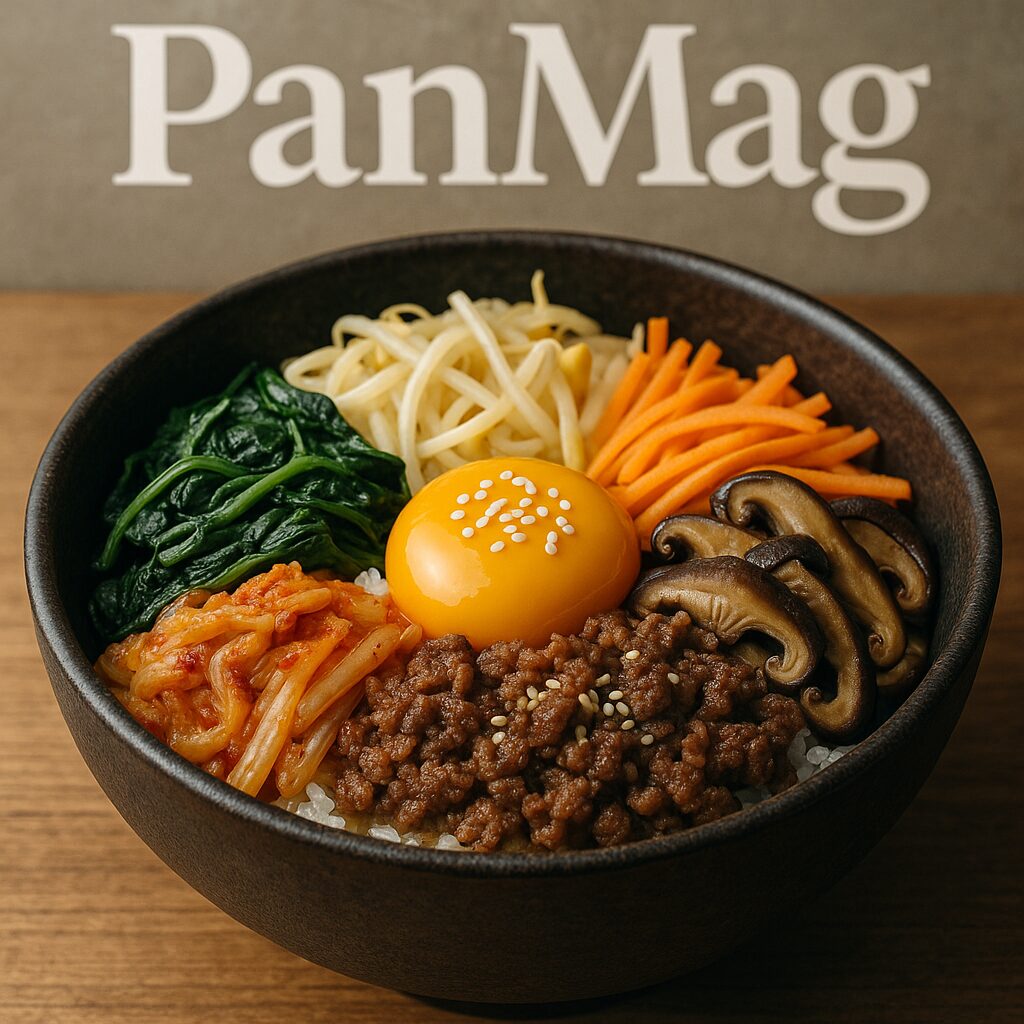Bibimbap Recipe
Summary:
The bibimbap recipe is more than just a meal; it celebrates flavors, colors, and textures. This Korean dish features a harmonious combination of savory vegetables, tender meat, and a rich, flavorful sauce piled onto a steamed rice bed. The beauty of bibimbap lies in its versatility – you can add your favorite protein, and the choice of vegetables can vary, but the vibrant flavors are always satisfying. In this bibimbap recipe, the combination of sweet, salty, and spicy ingredients comes together .
Equipment:
– Medium pot (for cooking rice)
– Work or large skillet (for stir-frying vegetables and meat)
– Spoon for mixing
– Knife and cutting board
– Small bowl (for sauce preparation)
– Serving bowl (large enough for all ingredients)
Ingredients:
– 2 cups steamed white rice (short-grain or jasmine rice preferred)
– 1 tablespoon sesame oil (for stir-frying vegetables)
– 1/2 cup spinach, blanched and chopped
– 1/2 cup bean sprouts, blanched
– 1/2 cup carrots, julienned
– 1/2 cup zucchini, julienned
– 1/2 pound ground beef or chicken (or tofu for vegetarian option)
– 2 eggs, fried sunny side up
– 1 tablespoon soy sauce
– 1 tablespoon gochujang (Korean chili paste)
– 1 teaspoon sesame seeds
– 1 teaspoon sugar
– 1 teaspoon rice vinegar
– 1 tablespoon green onion, chopped
– 1 tablespoon garlic, minced
– 1 tablespoon fresh lemon juice (optional, for a citrusy twist)
Instructions:
Step 1: Prepare the Vegetables and Protein
1. **First,** prepare the vegetables. Blanch the spinach and bean sprouts in boiling water for about 2 minutes, then drain them well and set aside. For the carrots and zucchini, julienne them into thin strips and set them aside for stir-frying.
2. **Next,** heat a tablespoon of sesame oil in a wok or large skillet over medium-high heat. Add the julienned carrots and zucchini, stir-fry for about 2-3 minutes until they soften but retain their vibrant color. Set aside.
3. **For the protein,** cook the ground beef or chicken in the same skillet, breaking it apart with a spatula. Stir in the soy sauce until the meat is browned and cooked through. If using tofu, press and crumble it before stir-frying in the skillet with sesame oil. Set the cooked protein aside.
Step 2: Make the Bibimbap Sauce
1. **In a small bowl,** combine the gochujang (Korean chili paste), sugar, rice vinegar, and sesame seeds. Stir in 1 tablespoon of lemon juice to add a citrus twist to the sauce. Mix everything well until the sauce is smooth. Adjust the sweetness or spice by adding more sugar or gochujang to taste.
2. **Pro Tip:** You can add a little soy sauce or a splash of water if you prefer a thinner sauce. Taste the sauce and adjust the flavor until you’re satisfied.
Step 3: Assemble the Bibimbap Bowl
1. **Now,** place a generous scoop of warm steamed rice into each serving bowl.
2. **Start layering the ingredients**: Arrange the cooked vegetables, meat (or tofu), and eggs on top of the rice in separate sections for a beautiful and colorful presentation. The vibrant vegetables and the soft, runny egg will contrast perfectly with the hot, sticky rice.
3. **For the finishing touch,** drizzle the bibimbap recipe sauce over the ingredients in the bowl, or serve it on the side for guests to mix in as they prefer. Garnish with a sprinkle of sesame seeds and chopped green onions.
Step 4: Mix and Enjoy
1. **Before eating,** gently mix all the ingredients so the sauce and flavors are well distributed throughout the rice. The warm rice, vegetables, meat, and egg will combine to create a savory, spicy, and rich flavor.
2. **Pro Tip:** If you like your bibimbap extra spicy, add more gochujang or chili oil. For a more balanced flavor, mix in a little extra sesame oil.

Notes:
– **Variations:** Feel free to customize the bibimbap recipe to suit your taste! You can add other vegetables like mushrooms, cucumbers, or pickled radish. Swap the protein for your favorite option, such as grilled pork or fish.
– **Vegetarian Option:** For a vegetarian or vegan bibimbap recipe , skip the meat and tofu. You can load the bowl with more vegetables and add a spoonful of kimchi for an extra kick.
– **Serving Tips:** Bibimbap recipe is best served hot and fresh, but it can also be stored in the refrigerator for up to 2 days. When reheating, add a splash of water to the rice and reheat in the microwave or on the stovetop with a lid.
– **Storing Leftovers:** If you have leftover bibimbap sauce, store it in an airtight container in the fridge for up to 1 week. You can use it on stir-fried vegetables or as a sauce for other dishes.
bibimbap recipe bibimbap recipe bibimbap recipe bibimbap recipe bibimbap recipe bibimbap recipe bibimbap recipe bibimbap recipe
